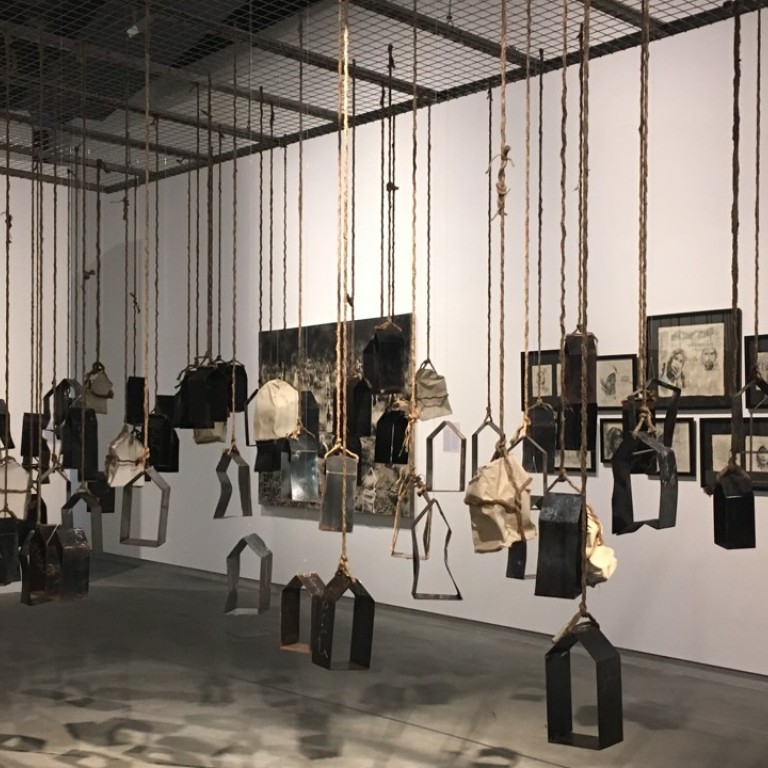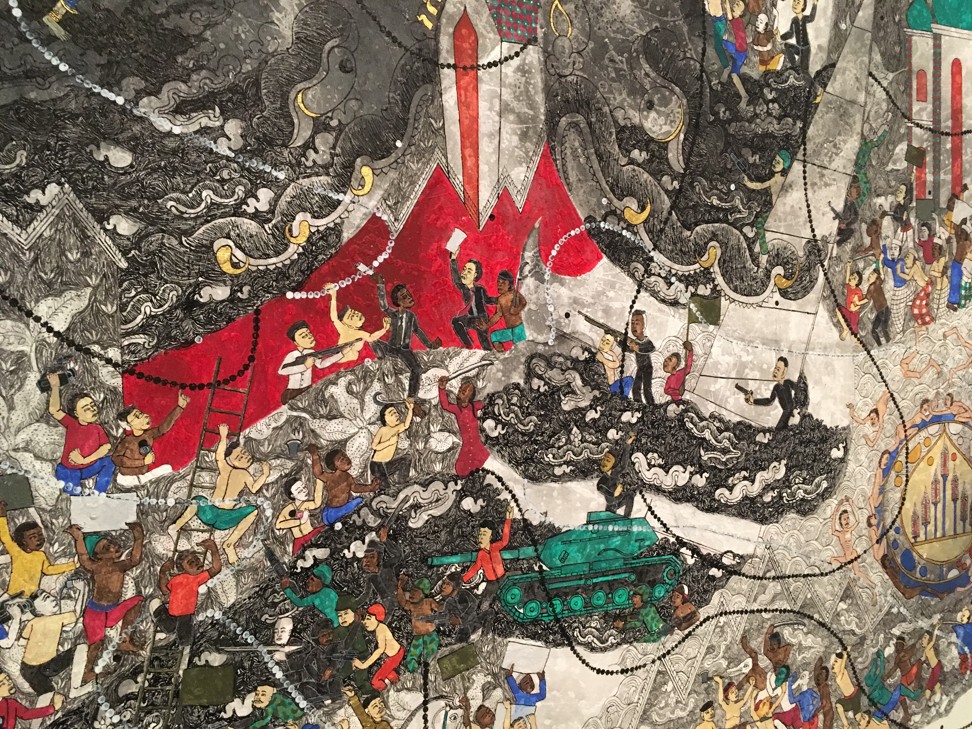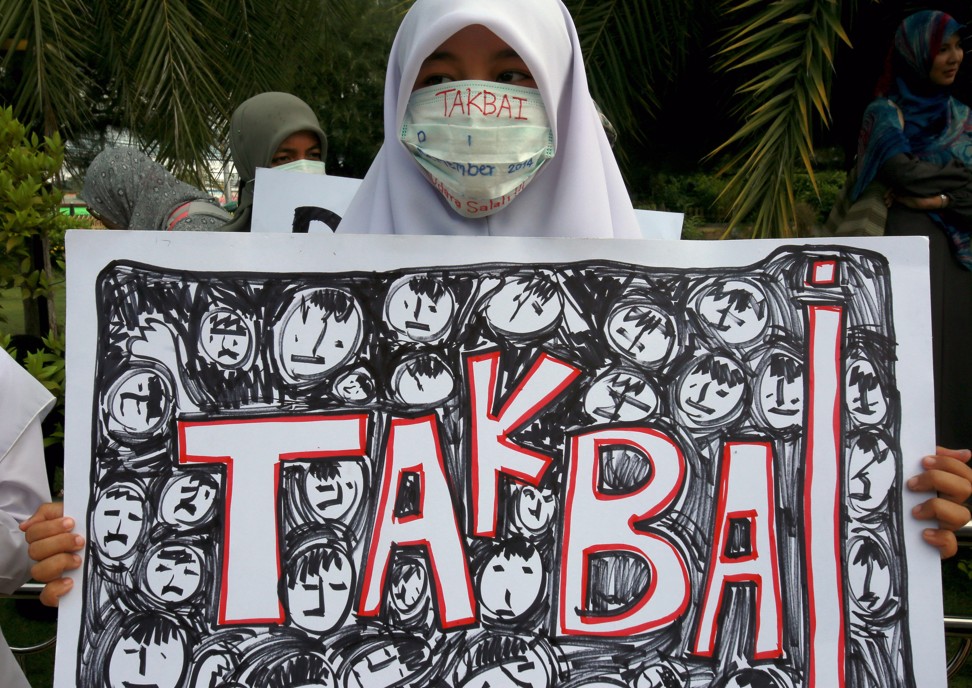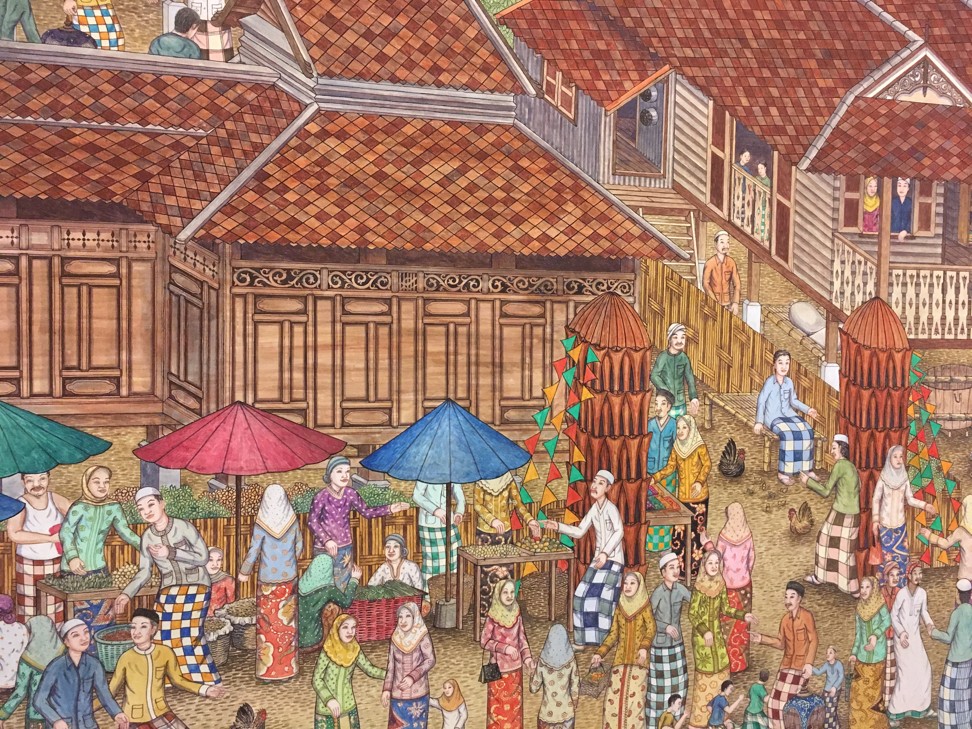
Malaysia art show demystifies conflict in southern Thailand, illustrating life under martial law and drawing on region’s history
Patani, Yala and Narathiwat, mainly Muslim, Malay-speaking provinces in Buddhist majority Thailand, are the focus of an exhibition in Kuala Lumpur prompted by the curiosity of curators from the north of the country
The insurgency in Thailand’s southern provinces bordering Malaysia is one of the least understood conflicts in Southeast Asia. While people in the region are aware of the Patani insurgency, as some call it, it is poorly reported on and explained.
An exhibition by artists from those provinces, and from northern Malaysia, sheds light on life under martial law in the predominantly Malay-speaking region.
LOOKING WITHIN: WHAT’S BEHIND THAILAND’S BUDDHIST-MUSLIM DIVIDE?
The exhibition, “Patani Semasa”, which roughly translates to Present Patani, introduces Malaysians to a region many know little about. It is running at the Ilham Gallery in the Malaysian capital, Kuala Lumpur, until July 15.

The exhibition is the brainchild of curators from the Maiiam Contemporary Art Museum in the northern Thai city of Chiang Mai. They wondered what kind of art was emerging from the troubled “deep south” of the country. Rahel Joseph, director of the Ilham Gallery, says the project began with the Maiiam curators visiting the area and its artists.
“What’s so valuable about this show is that it’s so well researched and well curated,” Joseph says. She says the curators looked beyond the current state of affairs in the area to its history as part of the Langkasuka kingdom, and its relationship to the rest of Southeast Asia.
The exhibition features 28 young artists, most of whom have lived and worked in Thailand’s deep south.

“I always wanted to share this exhibition with Malaysia and other Islamic countries, for example Indonesia,” says Gridthiya Gaweewong, one of the Maiiam curators and a celebrated figure in Thailand’s art scene. “For us, as Thais, it’s still relevant because the issues have not been resolved.”
The southern Thai provinces of Patani, Yala and Narathiwat have become synonymous with violence in the 14 years since tensions exploded in 2004 and Muslim insurgents launched a series of attacks on Buddhist civilians and Thai security forces.
The insurgents are demanding a separate state, or autonomy, for the Muslim-majority region, and it’s a deeply rooted issue.
Mascara and mosques: hidden lives of Thailand’s Muslim ladyboys
Historians say the northern Malay states of Kelantan and Terengganu, and the southern Thai provinces of Patani, Yala, Narathiwat and Songkhla, were once part of the Hindu-Buddhist kingdom of Langkasuka, established in the 2nd century. Around the 14th century, the Islamic sultanate of Patani was founded in the region.
In the 19th century, the sultanate was annexed by Siam (as Thailand was formerly known). However, Patani would not officially become part of the country until the Bangkok Treaty of 1909, which aimed to ward off encroaching colonial powers in the region.

In the 1930s, a process of enforced nationalism, or Thai-ification as it is now known, began. The people of the former sultanate pushed back against the cultural hegemony imposed by the Thai government. Their resistance led to the emergence of a separatist movement in the 1950s.
In 2004, failed attempts by then prime minister Thaksin Shinawatra to win the hearts and minds of insurgents led to deadly violence.
This is a struggle about nationality and identity first, and yes, religion is a part of that identity, but it is far from the overarching aim.
“I knew there was an insurgency, I knew there was trouble, but I didn’t know much about the history,” Joseph says. “This exhibition has been really educational.”
The exhibition is broadening Malaysians’ understanding of the region through imagery that at times contradicts how it is depicted in the media (eg. acts of violence). Some of the artists featured show “people going about their day … [being] peaceful”, Joseph says. “This is also their reality.”
Gridthiya says the exhibition also challenges preconceptions about Thailand and its contemporary art scene.
“What I find problematic with art in Thailand is that everything has become Bangkok-centric. We would like to decentralise the scene,” she says.
Although the exhibition’s main focus is on Thai artists, she and her co-curators also explore the fluidity of the Thai-Malaysian border. Included in the show is the work of Roslisham Ismail (also known as Ise), an artist from Malaysia’s Kelantan state, whose contribution includes an exploration of traditional cuisine from the border region.

The inclusion of a Malaysian in the exhibition may boost local interest in the show, and thereby help demystify the Patani region and its conflicts.
THE MUSEUMS BEHIND THE MURMURS OF A SOUTHEAST ASIAN RENAISSANCE
The conflict between state and citizens is the central theme of Maiiam’s exhibition. The artists depict life within fences and checkpoints. Joseph says that the exhibition is essentially “about looking at Patani through the eyes of the people who are actually living and working there”.
“[Stepping away] from what you read in the papers, the sensationalist headlines, you’re really looking at how art has been produced by people who have studied and lived there, who have family there,” says Joseph.

Many of the artworks speak directly to the violent reality of life in the border provinces, especially a controversial installation by Suhaidee Sata titled Symbols of Violence 11. The work simulates the experience of living life at gunpoint by encouraging viewers to walk down an aisle stacked with the muzzles of rifles made from coconut husks.
Suhaidee’s other works, including drawings of weapons, surround the installation, expressing the idea that conflict is always at the forefront of the artist’s mind.
“[Suhaidee] was asked why he doesn’t paint or draw nice pictures of landscapes. He said it’s because [these weapons] are his reality. Their cinemas, schools, markets are constantly being checked by soldiers who are so different, who speak Thai and are from Bangkok,” Joseph says.

Another installation, Remember at Tak Bai, invites the viewer into the black interior of a square box that looks like the Kaaba, the building at the heart of Islam’s most sacred place of worship. The inside is filled with the names of the 78 men who died after being bound and stacked in the back of a truck, and driven four hours to an army camp, in the district of Tak Bai in Narathiwat province, after a crackdown on protesters.
Both works thrust the viewer into the centre of the conflict and make the abstract concept of living life under martial law real.
According to Maximillian Morch, a scholar and freelance journalist specialising in Southeast Asia, the lack of context in reporting on the region has led to inaccurate parallels being drawn between the Muslims of the Thai border provinces and those in other Islam-linked conflict zones, such as Marawi in the southern Philippines.

“This is a struggle about nationality and identity first, and yes, religion is a part of that identity, but it is far from the overarching aim,” he says.
He adds that combining the issues of two distinct Muslim groups “delegitimises the local grievances” of southern Thai Muslims who feel their experiences are not represented in the mainstream Thai consciousness.
Thai army claims breakthrough pact with separatists in south
The contrasts of life in the Thai deep south is explored in depth throughout the exhibition. The soldiers policing the region are from other parts of Thailand, and have little ability to communicate with Malay-speaking locals.
This contradiction is reflected in Jehabdulloh Jehsorhoh’s The Way of Life of Malay Locals in Three Southernmost Provinces of Thailand, which mixes traditional Thai scenic forms with Malay motifs and imagery, and A Beautiful Flower Hidden in Patani, which expresses the intersection of Muslim life in Buddhist Thailand.

Is peace possible in the region? Although Mara Patani, the umbrella under which the insurgent groups organise themselves, and Thai authorities are engaged in peace talks, success has eluded all parties. Morch says that unless authorities address the “exclusion of Thai Malays from the Thai national consciousness”, no long-term solution will emerge.
“An inclusion in the national character, and an understanding of the history of the sultanate of Patani, would go a long way to understanding local dynamics and the basis of calls for independence or greater autonomy,” he says.
“The deep south has a long, fascinating history of tolerance, trade, different religions, and languages. I feel this history is far too easily overlooked in today’s narrative of it being a conflict-ridden area.”
